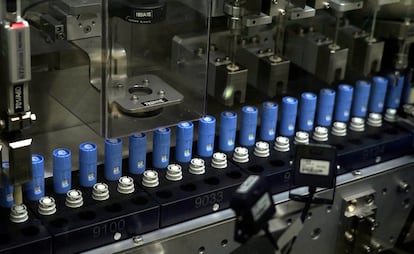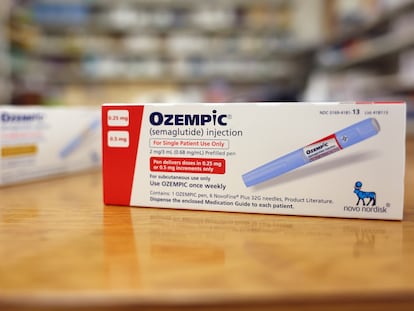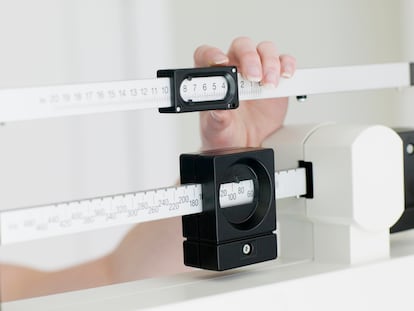Ozempic, or how the weight loss company has injected $560 billion into Novo Nordisk and Eli Lilly since 2023
Citi estimates that the fight against obesity will generate revenue of $158 billion in 2035. The main risk for the sector is the difficulty in guaranteeing supply
Obesity is the chronic pandemic that has become a target for pharmaceutical companies. Big pharma sees anti-obesity drugs as a business that will provide them with a juicy income in the years and, most likely, decades to come. What just a few years ago was one of Hollywood’s best-kept secrets has now become a stock market phenomenon — likewise on TikTok, where hundreds of content creators are sharing their weight loss journeys.
For now, Denmark’s Novo Nordisk and the U.S.’s Eli Lilly are the winners in this frenzy, although following in their wake are a legion of trials by dozens of pharmaceutical companies seeking their share of the pie.
The discovery that Ozempic, a drug developed in 2012 by Novo Nordisk for type 2 diabetes, helped with weight loss was a bonanza for drugmakers, with Citi analysts estimating the industry will top $158 billion by 2035. Despite the fact that taking the drug is only recommended for the treatment of diabetes, the Danish company has seen its sales take off in recent years. Sales of Mounjaro, from its competitor Eli Lilly, have also skyrocketed. Both Novo Nordisk and Eli Lilly have specific anti-obesity drugs: Wegovy and Zepbound, respectively — which are actually the same as diabetes treatments currently on the market, but which have now been approved to fight obesity.
The drugs’ most significant side effect has been a spectacular stock market revaluation for both companies. Since 2023, the Danish pharmaceutical company’s shares have soared by 76%, while those of its American competitor have risen by 107%, increasing their combined market value by about $605 billion. From the year’s highs, both companies have corrected by 3.8% and 3.3%, respectively, under pressure from investors who want to cash in.
In both cases, the drugs they manufacture are injected, which is why pharmaceutical companies are now aiming to launch new drugs in pill form. Competitors such as Amgen and Pfizer are also working on bringing anti-obesity pills to market, with their drugs at different stages of the approval process. The race is now on, and the pill with the fewest side effects will be the winner.
The anti-obesity gold mine led Novo Nordisk to become the most valuable European-listed company in 2023. Its market capitalization reached 3.87 trillion Danish kroner (about $561 million), and the company overtook the luxury conglomerate LVMH in market value. The anti-obesity drug accounted for 88% of its sales in 2022, according to UBS. Among the risks for the Danish company, the financial services company highlights increasing competition and the possible failure of Wegovy in the face of the high expectations for the anti-obesity drug business.
Ozempic and Wegovy have become Novo Nordisk’s bestsellers and have made a combined revenue of $33 billion since 2018. The pharmaceutical company is now the engine of the Danish economy. The company boosted its net profit by 50.7% to 8.4 billion Danish kroner ($1.21 billion). Among its challenges is being able to meet the growing demand, which is why Novo Holdings, the parent company of Novo Nordisk, recently acquired drugmaker Catalent. It is an operation for which it will spend $16.5 billion, including buying its debt.
In the case of Eli Lilly, the success of Mounjaro, which has also become one of its best-selling drugs, has catapulted it into the most valuable pharmaceutical company in the world. Its capitalization of more than $742 billion is more than double that of Merck, with $320 billion, and ahead of technology giants such as Tesla, whose market value now stands at $617 billion. Deutsche Bank analysts estimate it will make $10.2 billion through sales of Mounjaro this year — up from $5 billion in 2023 — and $2.4 billion with sales of Zepbound.
However, after the rise of its shares, the pharmaceutical company has exhausted its stock market potential, according to the analysts’ consensus compiled by Bloomberg. What’s more, the percentage of firms advising customers to buy the company’s stock has fallen to its lowest level in a year, although it remains at 72%.
But there are analysts who believe that these shares will continue to rally on the stock market. Morgan Stanley has set its target price at $950, compared to the current $755. Among the most cautious firms is Citi, which maintains a price target of $675 and highlights that the company trades at a P/E ratio for 2024 of 53 times, above the 20 times which is the average for the sector.

The market has all its hopes pinned on Zepbound. According to the trials carried out so far, the drug achieves greater weight loss than any of the drugs launched by Novo Nordisk. Analysts in the market have coined the phrase “JBL” (“just buy Lilly”), and firms such as Goldman Sachs believe that the drug will become the “future market leader” that will allow the company to control half of the market for weight loss drugs by 2030. The most optimistic estimates by analyst firms predict a turnover of $70 billion by 2030 from Zepbound alone, a figure that the U.S. investment bank has reduced by half.
Long gone are the years of the pandemic, in which the big winners were the pharmaceutical companies that managed to market Covid-19 vaccines that were effective and the first to be produced. Since the highs reached in 2020, Moderna’s shares have plummeted by 81%, reducing the company’s stock market value by more than $160 billion since then, while Pfizer’s shares have fallen by 54% and are trading at 2011 levels.
China will take over from the U.S.
The United States is currently the main destination for diabetes drugs, and accounts for 90% of Mounjaro’s 2023 sales and 95% of Wegovy’s turnover. According to estimates by the Food and Drug Administration (FDA), about 70% of U.S. adults are obese or overweight. However, pharmaceutical companies have set their sights on China. Investment banker Jefferies estimates that there are 200 million adults with obesity, out of a total population of more than 1.4 billion, and another 400 million who are overweight, of which the U.S. bank estimates that another 100 million will end up obese.
Sign up for our weekly newsletter to get more English-language news coverage from EL PAÍS USA Edition
Tu suscripción se está usando en otro dispositivo
¿Quieres añadir otro usuario a tu suscripción?
Si continúas leyendo en este dispositivo, no se podrá leer en el otro.
FlechaTu suscripción se está usando en otro dispositivo y solo puedes acceder a EL PAÍS desde un dispositivo a la vez.
Si quieres compartir tu cuenta, cambia tu suscripción a la modalidad Premium, así podrás añadir otro usuario. Cada uno accederá con su propia cuenta de email, lo que os permitirá personalizar vuestra experiencia en EL PAÍS.
¿Tienes una suscripción de empresa? Accede aquí para contratar más cuentas.
En el caso de no saber quién está usando tu cuenta, te recomendamos cambiar tu contraseña aquí.
Si decides continuar compartiendo tu cuenta, este mensaje se mostrará en tu dispositivo y en el de la otra persona que está usando tu cuenta de forma indefinida, afectando a tu experiencia de lectura. Puedes consultar aquí los términos y condiciones de la suscripción digital.
More information
Archived In
Últimas noticias
Welcome to the post-religion era: The idea of Christianity as the absolute truth has become obsolete
‘I thought you would like it’: The risky sexual practice popularized by TV shows and TikTok
The digitalization of tourism: ‘They promise experiences and gave us the worst possible one’
Mexican peso defies uncertainty with forecasts of a new period of stability in 2026
Most viewed
- Sinaloa Cartel war is taking its toll on Los Chapitos
- Reinhard Genzel, Nobel laureate in physics: ‘One-minute videos will never give you the truth’
- Oona Chaplin: ‘I told James Cameron that I was living in a treehouse and starting a permaculture project with a friend’
- Why the price of coffee has skyrocketed: from Brazilian plantations to specialty coffee houses
- Silver prices are going crazy: This is what’s fueling the rally











































